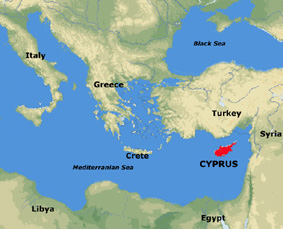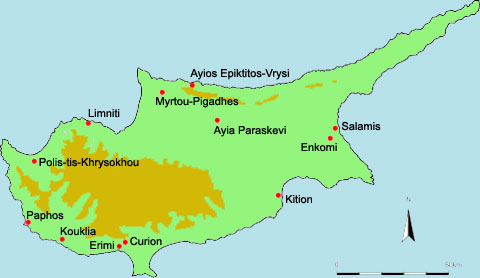Department of Antiquities
 |
Ancient Cyprus in the Ashmolean Museum |
Ancient Cyprus: Sites and Places |
||
|
|
The island of Cyprus lies at the eastern end of the Mediterranean,
close to the coasts of both Syria and Turkey. Of the early geographers, Strabo was one of the first actually to visit Cyprus; he completed his Geographiea about AD 23 and describes the island in the fourteenth book:
'in excellence it falls behind no one of the islands, for it is rich in wine and oil, and uses home-grown wheat. There are mines of copper in plenty.' |
|
|
|
||
|
The following lists a few key sites from each region from which the Ashmolean Museum contains objects.
|
||
|
Note: There has been considerable variation in the transliteration of place names from Greek to English over the past hundred years and more that the Ashmolean has been collecting material from Cyprus. Where possible, we refer to site names consistently. Where appropriate, we follow the format for archaeological site names with the name of the village on whose land the site is located occurring first, followed by the name of the site locality (e.g. Ayios Epiktitos-Vrysi; Myrtou-Pigadhes). It should be noted that many find locations are known only by a single village or locale name. |
||
| Previous
Page (The A.G. Leventis Gallery) |
Ancient Cyprus Introduction | Next
Page (Chronology) |



 There
are two mountain systems on the island, the Kyrenia range in the north,
and the Troödos in the west and central regions. Copper ores are
found on the northern and eastern slopes of the Troödos range,
and have been exploited since the Early Bronze Age. The flatter land
between the ranges and between the ranges and the sea has formed a focus
for human occupation on the island for thousands of years.
There
are two mountain systems on the island, the Kyrenia range in the north,
and the Troödos in the west and central regions. Copper ores are
found on the northern and eastern slopes of the Troödos range,
and have been exploited since the Early Bronze Age. The flatter land
between the ranges and between the ranges and the sea has formed a focus
for human occupation on the island for thousands of years.